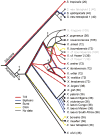Evolution of advertisement calls in African clawed frogs
- PMID: 24723737
- PMCID: PMC3978194
- DOI: 10.1163/000579511X569435
Evolution of advertisement calls in African clawed frogs
Abstract
For most frogs, advertisement calls are essential for reproductive success, conveying information on species identity, male quality, sexual state and location. While the evolutionary divergence of call characters has been examined in a number of species, the relative impacts of genetic drift or natural and sexual selection remain unclear. Insights into the evolutionary trajectory of vocal signals can be gained by examining how advertisement calls vary in a phylogenetic context. Evolution by genetic drift would be supported if more closely related species express more similar songs. Conversely, a poor correlation between evolutionary history and song expression would suggest evolution shaped by natural or sexual selection. Here, we measure seven song characters in 20 described and two undescribed species of African clawed frogs (genera Xenopus and Silurana) and four populations of X. laevis. We identify three call types - click, burst and trill - that can be distinguished by click number, call rate and intensity modulation. A fourth type is biphasic, consisting of two of the above. Call types vary in complexity from the simplest, a click, to the most complex, a biphasic call. Maximum parsimony analysis of variation in call type suggests that the ancestral type was of intermediate complexity. Each call type evolved independently more than once and call type is typically not shared by closely related species. These results indicate that call type is homoplasious and has low phylogenetic signal. We conclude that the evolution of call type is not due to genetic drift, but is under selective pressure.
Keywords: Silurana; Xenopus; call types; phylogenetic signal; vocal behaviour.
Figures







Similar articles
-
Premotor Neuron Divergence Reflects Vocal Evolution.J Neurosci. 2018 Jun 6;38(23):5325-5337. doi: 10.1523/JNEUROSCI.0089-18.2018. Epub 2018 May 21. J Neurosci. 2018. PMID: 29875228 Free PMC article.
-
Distinct neural and neuromuscular strategies underlie independent evolution of simplified advertisement calls.Proc Biol Sci. 2013 Feb 13;280(1756):20122639. doi: 10.1098/rspb.2012.2639. Print 2013 Apr 7. Proc Biol Sci. 2013. PMID: 23407829 Free PMC article.
-
Evolution of vocal patterns: tuning hindbrain circuits during species divergence.J Exp Biol. 2017 Mar 1;220(Pt 5):856-867. doi: 10.1242/jeb.146845. Epub 2016 Dec 23. J Exp Biol. 2017. PMID: 28011819 Free PMC article.
-
Host-defense peptides in skin secretions of African clawed frogs (Xenopodinae, Pipidae).Gen Comp Endocrinol. 2012 May 1;176(3):513-8. doi: 10.1016/j.ygcen.2011.10.010. Epub 2011 Oct 21. Gen Comp Endocrinol. 2012. PMID: 22036891 Review.
-
Mating vocalizations of female frogs: control and evolutionary mechanisms.Brain Behav Evol. 1999;53(4):187-97. doi: 10.1159/000006594. Brain Behav Evol. 1999. PMID: 10343085 Review.
Cited by
-
Convergent and divergent neural circuit architectures that support acoustic communication.Front Neural Circuits. 2022 Nov 17;16:976789. doi: 10.3389/fncir.2022.976789. eCollection 2022. Front Neural Circuits. 2022. PMID: 36466364 Free PMC article.
-
Genetics, Morphology, Advertisement Calls, and Historical Records Distinguish Six New Polyploid Species of African Clawed Frog (Xenopus, Pipidae) from West and Central Africa.PLoS One. 2015 Dec 16;10(12):e0142823. doi: 10.1371/journal.pone.0142823. eCollection 2015. PLoS One. 2015. PMID: 26672747 Free PMC article.
-
The 'silent' half: diversity, function and the critical knowledge gap on female frog vocalizations.Proc Biol Sci. 2025 May;292(2047):20250454. doi: 10.1098/rspb.2025.0454. Epub 2025 May 28. Proc Biol Sci. 2025. PMID: 40425166 Free PMC article. Review.
-
Advertisement call and genetic structure conservatism: good news for an endangered Neotropical frog.PeerJ. 2016 May 10;4:e2014. doi: 10.7717/peerj.2014. eCollection 2016. PeerJ. 2016. PMID: 27190717 Free PMC article.
-
The return to water in ancestral Xenopus was accompanied by a novel mechanism for producing and shaping vocal signals.Elife. 2019 Jan 8;8:e39946. doi: 10.7554/eLife.39946. Elife. 2019. PMID: 30618379 Free PMC article.
References
-
- Blackler AW, Fischberg M. Hybridization of two subspecies of Xenopus laevis. Rev Suisse Zool. 1965;72:841–857. - PubMed
-
- Blomberg SP, Garland T, Ives AR. Testing for phylogenetic signal in comparative data: behavioral traits are more labile. Evolution. 2003;57:717–745. - PubMed
-
- Bradbury JW, Vehrencamp SL. Principles of animal communication. Sinauer; Sunderland, MA: 1998.
Grants and funding
LinkOut - more resources
Full Text Sources
Miscellaneous
